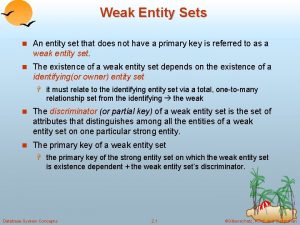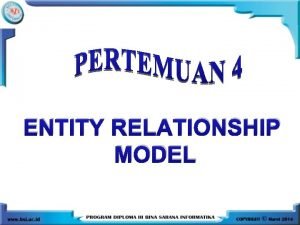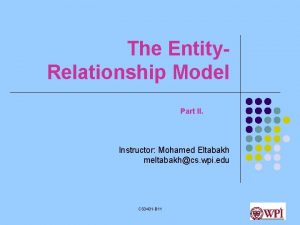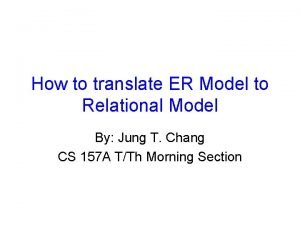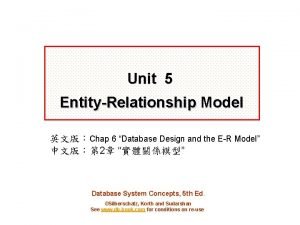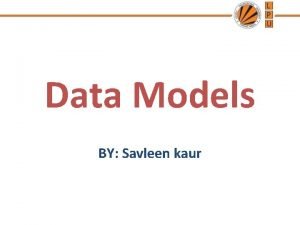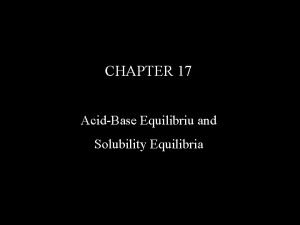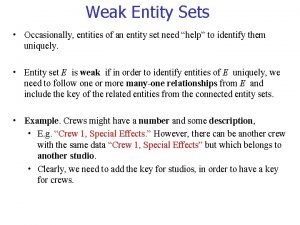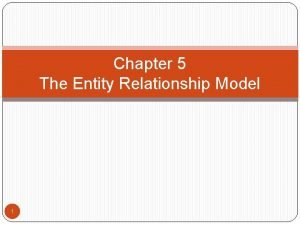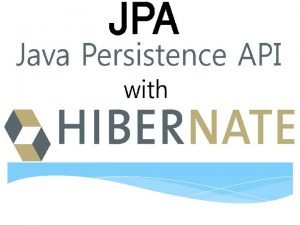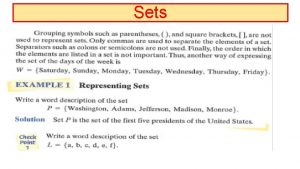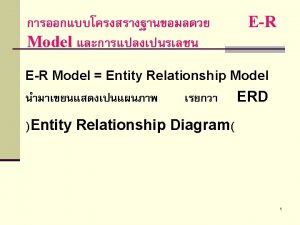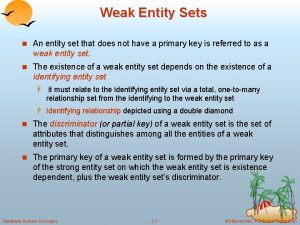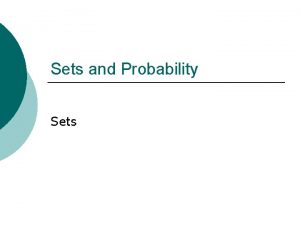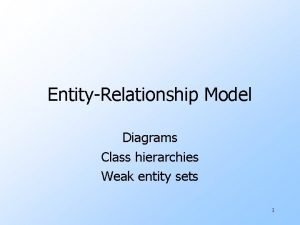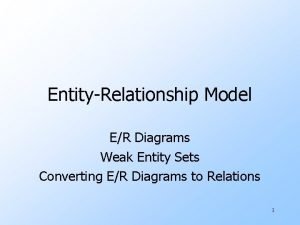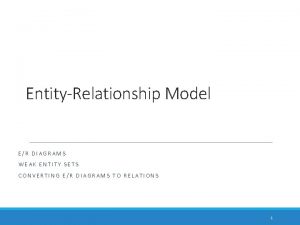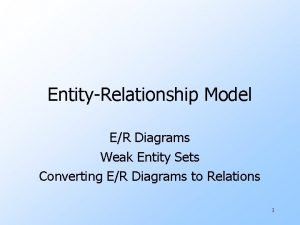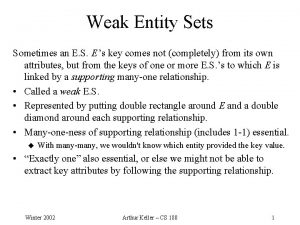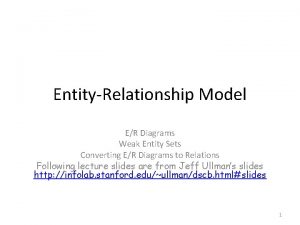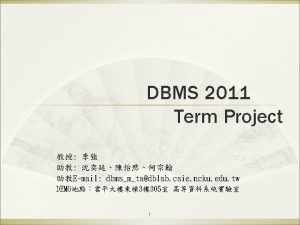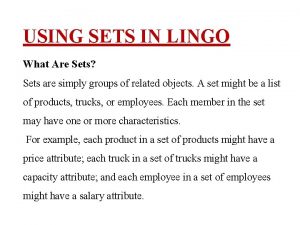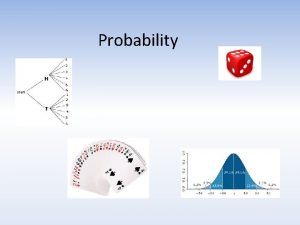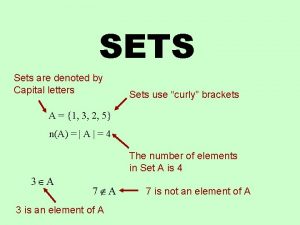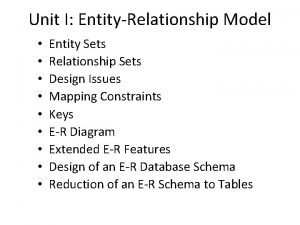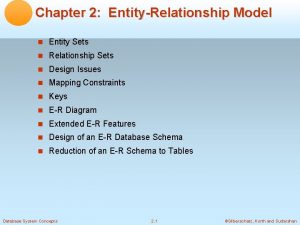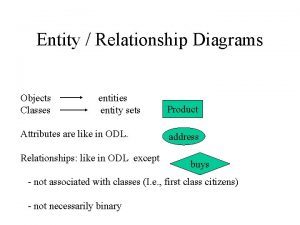Weak Entity Sets n An entity set that



























- Slides: 27

Weak Entity Sets n An entity set that does not have a primary key is referred to as a weak entity set. n The existence of a weak entity set depends on the existence of a identifying(or owner) entity set H it must relate to the identifying entity set via a total, one-to-many relationship set from the identifying the weak n The discriminator (or partial key) of a weak entity set is the set of attributes that distinguishes among all the entities of a weak entity set on one particular strong entity. n The primary key of a weak entity set H the primary key of the strong entity set on which the weak entity set is existence dependent + the weak entity set’s discriminator. Database System Concepts 2. 1 ©Silberschatz, Korth and Sudarshan

Weak Entity Sets (Cont. ) n Weak entity set by double rectangles. n Identifying relationship set by a double diamond n Underline the discriminator of a weak entity set with a dashed line. n payment-number – discriminator of the payment entity set n Primary key for payment – (loan-number, payment-number) Database System Concepts 2. 2 ©Silberschatz, Korth and Sudarshan

Weak Entity Set Example n Example H Offerings of a course at a university H The same course may be offered in different semesters H There may be several sections for the same course within a semester n A course is a strong entity and a course-offering can be modeled as a weak entity n The discriminator of course-offering would be semester (including year) and section-number n Alternative H If we model course-offering as a strong entity we would model coursenumber as an attribute. The relationship with course would be implicit in the course-number attribute Database System Concepts 2. 3 ©Silberschatz, Korth and Sudarshan

참고: Existence Dependencies n If the existence of entity x depends on the existence of entity y, then x is said to be existence dependent on y. loan-payment If a loan entity is deleted, then all its associated payment entities must be deleted also. Database System Concepts 2. 4 ©Silberschatz, Korth and Sudarshan

Extended E-R n Specialization n Generalization n Aggregation Database System Concepts 2. 5 ©Silberschatz, Korth and Sudarshan

Specialization n Top-down design process; we designate subgroupings within an entity set that are distinctive from other entities in the set. n These subgroupings become lower-level entity sets that have attributes or participate in relationships that do not apply to the higher-level entity set. n Depicted by a triangle component labeled ISA n Attribute inheritance – a lower-level entity set inherits all the attributes and relationship participation of the higher-level entity set to which it is linked. Database System Concepts 2. 6 ©Silberschatz, Korth and Sudarshan

Specialization Example Database System Concepts 2. 7 ©Silberschatz, Korth and Sudarshan

Generalization n A bottom-up design process – combine a number of entity sets that share the same features into a higher-level entity set. n Specialization and generalization are simple inversions of each other; they are represented in an E-R diagram in the same way. n The ISA relationship also referred to as superclass - subclass relationship Database System Concepts 2. 8 ©Silberschatz, Korth and Sudarshan

Design Constraints on a Specialization/Generalization n Constraint on which entities can be members of a given lower- level entity set. H Condition-defined : evaluated by an explicit condition or predicate. H User-defined : database user assigns n Constraint on whether or not entities may belong to more than one lower-level entity set within a single generalization. H Disjoint 4 An entity can belong to only one lower-level entity set 4 Noted in E-R diagram by writing disjoint next to the ISA triangle H Overlapping 4 an entity can belong to more than one lower-level entity set Database System Concepts 2. 9 ©Silberschatz, Korth and Sudarshan

Design Constraints on a Specialization/Generalization (Contd. ) n Completeness constraint H Total : an entity must belong to one of the lower-level entity sets H Partial : an entity need not belong to one of the lower-level entity sets Database System Concepts 2. 10 ©Silberschatz, Korth and Sudarshan

Aggregation n Consider the ternary relationship works-on, which we saw earlier n Suppose we want to record managers for tasks performed by an employee at a branch Database System Concepts 2. 11 ©Silberschatz, Korth and Sudarshan

Aggregation (Cont. ) n Relationship sets works-on and manages represent overlapping information H Every manages relationship corresponds to a works-on relationship H However, some works-on relationships may not correspond to any manages relationships we can’t discard the works-on relationship n Redundancy problem aggregation Database System Concepts 2. 12 ©Silberschatz, Korth and Sudarshan

Design Decisions of an E-R Database Schema n The use of an attribute or entity set to represent an object. n Whether a real-world concept is best expressed by an entity set or a relationship set. n The use of a ternary relationship versus a pair of binary relationships. n The use of a strong or weak entity set. n The use of specialization/generalization – contributes to modularity in the design. n The use of aggregation – can treat the aggregate entity set as a single unit without concern for the details of its internal structure. Database System Concepts 2. 13 ©Silberschatz, Korth and Sudarshan

E-R Diagram for a Banking Enterprise Database System Concepts 2. 14 ©Silberschatz, Korth and Sudarshan

Summary of Symbols Database System Concepts 2. 15 ©Silberschatz, Korth and Sudarshan

Summary of Symbols (Cont. ) Database System Concepts 2. 16 ©Silberschatz, Korth and Sudarshan

Alternative E-R Notations Database System Concepts 2. 17 ©Silberschatz, Korth and Sudarshan

Reduction of an E-R Schema to Tables n A database which conforms to an E-R diagram can be represented by a collection of tables. n For each entity set and relationship set there is a unique table which is assigned the name of the corresponding entity set or relationship set. n Each table has a number of columns (generally corresponding to attributes), which have unique names. n Converting an E-R diagram to a table format is the basis for deriving a relational database design from an E-R diagram. Database System Concepts 2. 18 ©Silberschatz, Korth and Sudarshan

Representing Entity Sets as Tables n A strong entity set reduces to a table with the same attributes. Database System Concepts 2. 19 ©Silberschatz, Korth and Sudarshan

Composite and Multivalued Attributes n Composite attributes are flattened out by creating a separate attribute for each component attribute H E. g. given entity set customer with composite attribute name with component attributes first-name and last-name the table corresponding to the entity set has two attributes name. first-name and name. last-name n A multivalued attribute M of an entity E is represented by a separate table EM H Table EM has attributes corresponding to the primary key of E and an attribute corresponding to multivalued attribute M H E. g. Multivalued attribute dependent-names of employee is represented by a table employee-dependent-names(employee-id, dname) Database System Concepts 2. 20 ©Silberschatz, Korth and Sudarshan

Representing Weak Entity Sets n A weak entity set becomes a table that includes a column for the primary key of the identifying strong entity set Database System Concepts 2. 21 ©Silberschatz, Korth and Sudarshan

Representing Relationship Sets as Tables n A many-to-many relationship set H Primary keys of the participating entity sets + Attributes of the relationship set. Database System Concepts 2. 22 ©Silberschatz, Korth and Sudarshan

Redundancy of Tables n Many-to-one and one-to-many relationship sets that are total on the many-side can be represented by adding an extra attribute to the many side, containing the primary key of the one side n E. g. : Instead of creating a table for relationship accountbranch, add an attribute branch to the entity set account Database System Concepts 2. 23 ©Silberschatz, Korth and Sudarshan

Redundancy of Tables (Cont. ) n For one-to-one relationship sets, either side can be chosen to act as the “many” side H That is, extra attribute can be added to either of the tables corresponding to the two entity sets n If participation is partial on the many side, replacing a table by an extra attribute in the relation corresponding to the “many” side could result in null values n The table corresponding to a relationship set linking a weak entity set to its identifying strong entity set is redundant. does not need table Database System Concepts 2. 24 ©Silberschatz, Korth and Sudarshan

Representing Specialization as Tables n Method 1: H Form a table for the higher level entity H Form a table for each lower level entity set, include primary key of higher level entity set and local attributes table attributes person name, street, city customer name, credit-rating employee name, salary H Drawback: getting information about, e. g. , employee requires accessing two tables Database System Concepts 2. 25 ©Silberschatz, Korth and Sudarshan

Representing Specialization as Tables (Cont. ) n Method 2: H Form a table for each entity set with all local and inherited attributes table attributes person name, street, city customer name, street, city, credit-rating employee name, street, city, salary H If specialization is total, table for generalized entity (person) not required to store information 4 Can be defined as a “view” relation containing union of specialization tables H Drawback: street and city may be stored redundantly for persons who are both customers and employees Database System Concepts 2. 26 ©Silberschatz, Korth and Sudarshan

Relations Corresponding to Aggregation n To represent aggregation, create a table containing H primary key of the aggregated relationship H the primary key of the associated entity set H Any descriptive attributes H Attributes of the relationship set(If exist) Transform the relationship sets and entity sets within the aggregated entity n Database System Concepts Create a table, manages(employee-id, branch-name, title, manager-name) 2. 27 ©Silberschatz, Korth and Sudarshan
 Entity set
Entity set Cardinality ratio adalah
Cardinality ratio adalah Contoh weak entity
Contoh weak entity Composite multivalued attribute
Composite multivalued attribute Discriminator in weak entity set
Discriminator in weak entity set A weak entity set can exist alone
A weak entity set can exist alone Ternary relationship example
Ternary relationship example Total set awareness set consideration set
Total set awareness set consideration set Training set validation set test set
Training set validation set test set Removing redundant attributes in entity sets
Removing redundant attributes in entity sets Weak acid and weak base reaction
Weak acid and weak base reaction What are strong bases
What are strong bases Strong acid-strong base titration indicator
Strong acid-strong base titration indicator Thể thơ truyền thống
Thể thơ truyền thống Block xoang nhĩ là gì
Block xoang nhĩ là gì Hãy nói thật ít để làm được nhiều
Hãy nói thật ít để làm được nhiều Thơ thất ngôn tứ tuyệt đường luật
Thơ thất ngôn tứ tuyệt đường luật Tôn thất thuyết là ai
Tôn thất thuyết là ai Walmart thất bại ở nhật
Walmart thất bại ở nhật Gây tê cơ vuông thắt lưng
Gây tê cơ vuông thắt lưng Phân độ lown ngoại tâm thu
Phân độ lown ngoại tâm thu Tìm độ lớn thật của tam giác abc
Tìm độ lớn thật của tam giác abc Sau thất bại ở hồ điển triệt
Sau thất bại ở hồ điển triệt Weak entity example
Weak entity example Weak entity
Weak entity Er diagram dependency
Er diagram dependency @transient in jpa
@transient in jpa Optional and mandatory relationship in erd
Optional and mandatory relationship in erd
